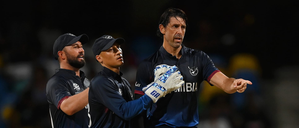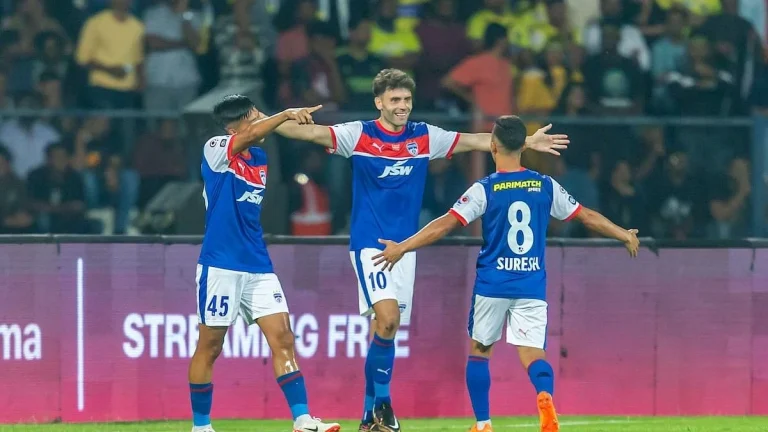I can only control what I have and focus on my gameplan as a batter, says Easwaran

New Delhi, Oct 10 (IANS) Come October 11, and another season of Ranji Trophy will kickstart in India with a twist. India’s prestigious first-class competition will be played in two phases this time: teams will play five matches before taking a break for the Syed Mushtaq Ali Trophy and Vijay Hazare Trophy.
Teams will converge again for the second phase of the Ranji Trophy starting on January 25 next year. But for now, the first phase holds huge importance for many players on the radar for India ‘A’ red-ball tour of Australia, and the all-important five-match Border-Gavaskar Trophy.
Bengal opener Abhimanyu Easwaran is coming into the Ranji Trophy on the back of three centuries hit in the Duleep Trophy and Irani Cup. With over 7,506 runs in 98 First-Class games at an average of 47.65, Easwaran is on the cusp of playing his 100th red-ball game via the second round of the competition.
In an exclusive conversation with IANS, Easwaran speaks about the Bengal team selected for the Ranji Trophy, his style of preparations, mental make-up, how he navigates batting in first-class cricket, and the joy he derives from playing the longer format. Excerpts:
Q. The Ranji Trophy is just around the corner. What are your thoughts on the change in its schedule?
A. Every Ranji season is exciting. Honestly, everybody is really looking forward to it. We’re playing five red-ball games and then there’s white-ball tournaments coming up and then red-ball matches come again. It’s a good change because as a cricketer, you want to have that ability to switch between formats. Playing the Ranji Trophy altogether was getting hectic at times because of the lack of breaks, so it’s a good initiative.
Q. Bengal sees the return of Wriddhiman Saha and Sudip Chatterjee for this Ranji Trophy. What do you make of the overall make-up of the squad?
A. It looks like a really good team. There’s a lot of experience because I feel Wriddhiman Saha and Sudeep Chatterjee have played for Bengal. Wriddhi has played for India a lot, so he brings a lot of experience. Sudeep has also played a lot of first-class cricket and obviously, Anustup (Majumdar, captain) has been doing well for the past five, or six years. He’s been incredible for us and we’ve got a lot of youngsters coming as well. So it’s a really mixed group, which is really exciting to see.
Q. Since recovering from a hamstring injury, you have made three centuries in this domestic season. How do you assess your performances so far?
A. Performances have been decent because I was coming after an injury. So I was looking forward to getting back to the game and I’ve spent some really good time in the middle and really enjoyed it. I’ve got a few runs, so I’m really happy about that. But I’m really looking forward to the Ranji Trophy now. I just want to keep it simple and keep doing the things I’m doing well.
Q. What was the biggest takeaway for you in terms of recovering from the injury and coming back to score big runs?
A. I feel injury can get really frustrating at times to begin with because you’re doing one session a day and then you’re just in the hotel. So it gets really frustrating at times. I didn’t bat for about 45-50 days from the date when I got the injury, and it was frustrating. But then I got a lot of clarity as to what other things I can focus on when I start batting. Like, how can I improve when I come out to bat and what things I can change for the season or the adjustments I can make. So it gave me a lot of clarity and patience because batting is something I love and I couldn’t do it for a long time. So it gave me a new freshness when I began playing.
Q. You have been playing first-class cricket for over a decade. How would you sum up your journey till now?
A. To sum up 10 years in brief is actually tough, but I’d say it’s been a really good journey. There have been a lot of ups and downs. I have really enjoyed this journey. I made my Ranji debut at the age of 18, and to be here after 10-11 years is really good. I’ve enjoyed it a lot. I’ve made a lot of memories on the way, which I’ll remember for my lifetime. So it’s been really nice.
Q. What are the points you focus on from a preparation perspective – from a playing as well as a mental perspective?
A. The preparation for me is usually done in the off-season. This is the time I try and just get used to the pitches here and the conditions – that is all I do because I feel in the Ranji Trophy, the biggest challenge is that you play at different venues every single game. So suppose we are playing in Lucknow this game, there will be a different wicket. We’ll probably play on a red soil wicket. Once we go back, we’re playing a home game next. So we will probably play on a black-soil pitch, which is a lot greener and there’ll be a lot of help for the fast bowlers. We’ve got a good fast bowling unit.
So the challenge is to get used to the conditions and that is all I try to focus on, understanding how I can score runs in these conditions, what adjustments I can make, and the areas I can score in on a certain pitch or against a certain bowler. So those are things I try and focus on and then obviously play the situation. Whatever my team demands of me in that particular situation, I try and focus on that. Also, I do a bit of visualization before every game.
Q. What is your way of navigating out of tough situations with the bat in red-ball games?
A. I try and focus on the task at hand mainly. All I can do is control the things I have in hand and try and make sure I have a solid game plan as a batter and just try to execute that. It gives me more clarity and whenever I feel there is a lot of confusion in my mind, I just try and focus on what my team needs from me at that point. That gives me a lot of clarity about what I need to do at that point.
Q. How challenging does it become to maintain the hunger for making big runs in the domestic season?
A. That’s not really a challenge. Everybody wants to score big runs. It is just about trying to take it one day at a time. If you had a good day or a bad day on the field, you have to just move forward, learn from it and move forward – that is what I’ve learned in so many years. That is a very big challenge, to be honest. But I think you need to learn from it and move forward. If I got a hundred in the last game, that doesn’t really change.
Q. Do you have any specific goals in mind for yourself when you enter a new domestic season?
A. I don’t keep any personal milestones in mind. I am not somebody who will target X amount of runs in X number of games. I just try and take it one day at a time. My goal is obviously to make sure my team wins. For the team, the first goal is obviously to qualify. For that to happen, again, you have to break it down to one game at a time. So our focus is just on the first game against U.P. We’ve got a really good team. If we can play to our potential, I’m sure we can do really, really well this season.
Q. What has been the greatest source of joy for you in playing red-ball cricket?
A. I feel there’s a lot of joy when you do play red-ball cricket. I mean, if the wicket is a little challenging and just to play out a spell, it feels great. To field for two days like I did in the Irani Trophy and then to come out and play a big innings, is very satisfying. It’s because no matter how hard you work in practice, you can never relate that to a game because you are never off the field – 12 hours of fielding, and then you get to bat. So, there are a lot of joys in playing red-ball cricket and if you work hard for five days and at the end of the fifth day, you win a game, that is a very satisfying feeling.
It’s great that white-ball cricket is getting a lot of coverage. A lot of T20 tournaments and leagues are coming up, which is great for the game because it’s giving a lot of opportunity to a lot of cricketers. But I still feel that red-ball cricket is the purest format and it actually tests your character a lot more than any other format.
Q. How do you unwind after a long day on the field?
A. I talk a lot with my family. I’ve got a niece, who’s two and a half; I love talking to her a lot. I watch a lot of series and movies that keep me going. I really enjoy doing that. There are a lot of series which I really like. I loved watching The Last Dance and enjoyed watching The Test too. At the same time, I try and avoid watching something sporty during my games, but sometimes it happens.
Q. How crucial has been the support of your family in you becoming who you are currently in cricket?
A. My family is like that (very supportive). My dad obviously supported me a lot when I was really young because to shift your kid at the age of 10 to another state to play cricket is amazing. I was very lucky to be able to do that because Uttarakhand did not have a state team at that time. My biggest supporters have also been my mom and sister – they’ve supported me like anything. They do a lot of superstitions when I’m playing. My sister doesn’t really eat and my mom will keep reading her paath (prayers). So, they’re very superstitious.
Even if I’ve had a bad day at the field, they will be the first people to call and just tell me it’s okay, it happens. I’m very lucky to have a family like that. My mother and sister didn’t understand cricket initially, but now they know everything. If you ask them what the rules are, they’ll probably know it better than a lot of players.
–IANS
nr/bsk/





